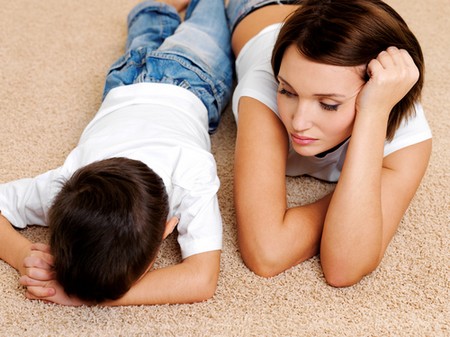Just as marriage has increased in popularity this decade, so too has remarriage. The remarriage rate is now more than 50 percent higher than it was thirty years ago, which means that almost three children out of ten are living with one natural parent and one stepparent. The chances that a second marriage will succeed are even less than the chances that a first marriage will succeed. Of those couples who reconcile their differences and remarry the same partner, more than 50 percent separate within two years. Of those who marry a new partner, 50 percent separate within three years. Couples in a second marriage experience different problems from those in a first marriage. Surveys have shown that difficulties in a first marriage usually stem from emotional immaturity, sexual dissatisfaction, and worry over money problems, with children at the bottom of the list.
Couples in a second marriage report that the greatest area of conflict is the management of their children.
Parents shouldn’t expect their child to welcome a remarriage with open arms; previous experience has taught the child that moms and dads don’t stay together forever. No wonder the child is apprehensive about the possibility of living through another period with lots of arguments and ill-feeling. The child has to learn to trust the stability of her new family, and this takes time.
A child’s adjustment to a remarriage depends on factors relating to the following:
- Acceptance of the previous loss. Your child may unconsciously deny that her parents have separated. This is a natural defense; but the remarriage won’t work until the child accepts that the previous marriage is over.
- Gap between marriages. A short gap leaves a child too little time to get over the trauma of divorce before facing the impact of the new family. A long gap between marriages is not the best solution either, because the child may become used to having her parent all to herself and may be reluctant to share the parent with a stepparent.
- Divided loyalties. When a family break-up arises from divorce, a child really has three parents: her two natural parents and her stepparent. The child may feel her loyalties are stretched. Yet, in many happy remarried families, a child still sees both natural parents.
- Parental jealousy. Ex-spouses may be jealous when their former partner remarries, and this may influence a child’s perception of her new stepparent. However, every child is capable of having a good relationship with a stepparent and a natural parent at the same time. Each relationship contributes to the child’s development in its own way.
- Child’s age. Younger children are better at adjusting to a new stepparent than are school-aged children. Adolescents frequently have problems adapting to a new family structure.
- Parental responsibilities. The stepfather often assumes full responsibilities too soon, before the stepchild is ready to accept him. It is usually best for a stepparent to take parental responsibilities gradually.
Many second marriages involve an amalgamation of two sets of children from two previous marriages, and there may be jealousy between them. This is most marked when the children are of the same age; each child feels threatened by the other, afraid her parent’s love for her will diminish. Most parents are able to form good relationships with their stepchildren when they have their natural children living with them as well.
When a second marriage produces a new baby, any existing children in the family may feel insecure. They need reassurance. Some couples in a remarriage decide not to have a baby of their own because of the detrimental effect the baby could have on the other children. This is a personal decision, but it does seem a rather drastic measure to take in order to avoid a potential pitfall. Every child adds a new and unique dimension to a family. In fact, one study has demonstrated that relationships between parents and children in stepfamilies, and between the children themselves, are better when the couple have children of their own. A natural child in a stepfamily seems to act as a binding force.
Although the fairy-tale stereotype of a stepparent is someone who is wicked, uncaring, and selfish, this pessimistic view has little basis in reality. Studies on the effects of remarriage on children (involving thousands of stepfamilies with at least one stepchild) have found the following:
- Six out of ten families think family relationships are excellent, two out often think family relationships are good, and only two out often think they are poor.
- The age of the stepmother at the time of remarriage is important. More stepmothers over the age of forty report excellent relationships with their stepchildren than younger stepmothers. The age of the stepfather does not appear to matter as much.
- Nearly twice as many children under the age of thirteen have excellent relationships with their stepmothers than older children, although the age of the children has no effect on their relationships with their stepfathers.
- Stepfathers are more likely to form close connections with their stepchildren than are stepmothers, particularly if the stepchild is a boy; stepfathers also tend to be more competent than fathers in intact families.
- The self-image of a child in a remarriage is no different from that of a child in an original family. Being in a stepfamily does not adversely affect the way a child sees herself, or alter her feelings of personal worth.
Categories
Advertisements
Recent Articles
 How to Understand Bed Sizes – A Small Guide
How to Understand Bed Sizes – A Small Guide How to Select Some Must Have Kitchen Accessories
How to Select Some Must Have Kitchen Accessories Best Way to Change a Car Tire
Best Way to Change a Car Tire Best Way to Write an Affirmation
Best Way to Write an Affirmation Best Way to Take Charge of Your Financial Life
Best Way to Take Charge of Your Financial Life Best Way to Survive a Party When You Don’t Know Anyone
Best Way to Survive a Party When You Don’t Know Anyone Best Way to Stop Self Sabotaging Yourself
Best Way to Stop Self Sabotaging Yourself Best Way to Start Journal Writing
Best Way to Start Journal Writing Best Way to Speak with a Powerful Voice
Best Way to Speak with a Powerful Voice Best Way to Simplify Your Life
Best Way to Simplify Your Life Best Way to Respond to a Put-Down
Best Way to Respond to a Put-Down Best Way to Reduce Acne Breakouts
Best Way to Reduce Acne Breakouts Best Way to Recover from Dining Disasters
Best Way to Recover from Dining Disasters Best Way to Quit Your Job Gracefully
Best Way to Quit Your Job Gracefully Best Way to Make Your Own Website
Best Way to Make Your Own Website




Leave a Reply